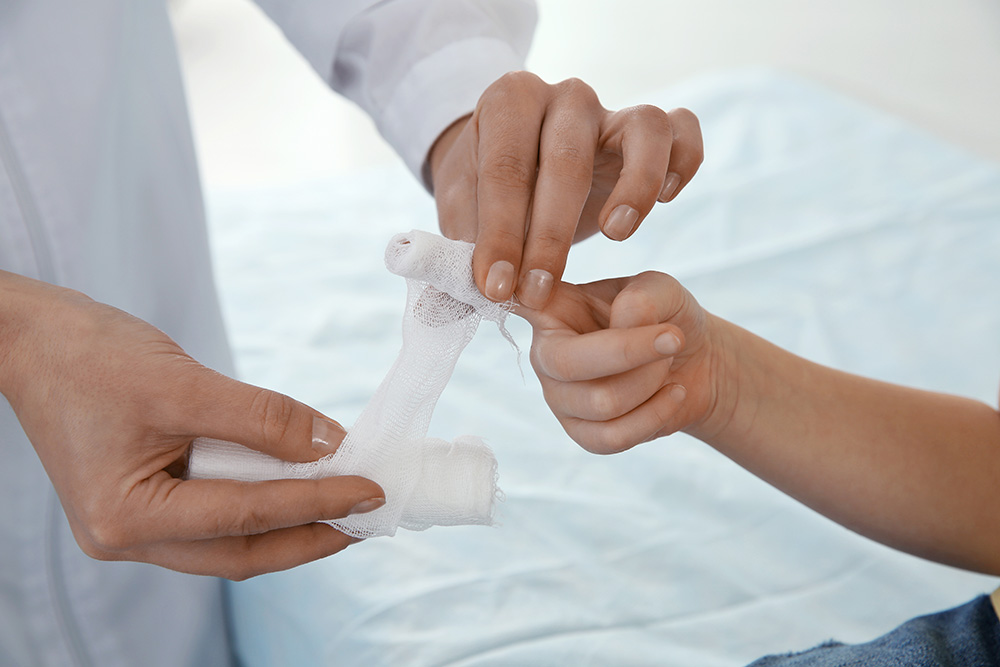When a child injures a finger, it’s not always easy to tell if it’s a jammed finger or something more serious, like a fracture. Kids are active, after all, and their fingers often take a hit during sports and play.
A jammed finger happens when the finger is hit or bent forcefully, causing pain and swelling. But sometimes, the damage is worse, and the finger might be broken.
What is a Jammed Finger?
Essentially, the term “jammed finger” describes how the injury occurred rather than the injury itself. It’s a colloquial phrase that can refer to several injuries involving the first two joints of the fingers, including sprains, dislocations, and fractures.
These injuries often result from playing sports, particularly those involving catching or throwing balls with great force, but they can also occur in contact sports or during a fall when you reach forward to break your fall.
How Do You Jam Your Finger?
A jammed finger injury typically occurs when your hand is positioned in a claw-like shape, with your fingers partially bent but the hand still open. The tips of the fingers face the force of an object, such as a ball traveling through the air. When the ball makes contact, the impact forcefully pushes the fingers too far backward or at an awkward angle, causing the ligaments to sprain, the joints to dislocate, or the bone to fracture.
Jammed Finger vs. Broken Finger
Because “jammed finger” is not a clinical term, experiencing this kind of injury doesn’t necessarily mean the bone isn’t broken; it simply means the type of force or nature of the injury could result in a sprain, dislocation, or fracture.
It isn’t always immediately evident whether the injury is a sprain, dislocation, or fracture. The best course of action is to visit an urgent care center for immediate medical attention. Having the injury examined promptly can prevent potential complications, further injury, and improper healing.
How to Tell if a Finger is Fractured
A fracture isn’t always obvious, but there are clear signs to watch for, including the following:
- Bruising and swelling: These are common signs of a broken finger in a child.
- Severe pain: If the pain doesn’t ease, it could mean a fracture.
- Stiffness: The finger might be hard to move.
- Abnormal shape: If the finger looks crooked or out of shape, it’s likely broken.
If you notice these signs, the first step is to keep the finger still and avoid letting your child use it. Apply ice to reduce swelling and ease the pain. If the pain doesn’t improve or the finger looks deformed, it’s time to visit urgent care.
How is a Jammed Finger Diagnosed?
When you bring your child to Thibodaux Regional Urgent Care, our team will start with a thorough exam. You can expect the following:
- Physical exam: The physician will ask about the symptoms and how the injury happened.
- Mobility test: They’ll check how well the finger moves.
- Joint examination: The joints will be carefully examined for damage.
- Imaging tests: X-rays will confirm if it’s a sprain or a break. Sometimes, an MRI is required to check for soft tissue damage.
Jammed or Fractured Finger? How Thibodaux Regional Urgent Care Can Help
At Thibodaux Regional Urgent Care, we’re here for your family with compassionate, dedicated care. We know how worrying it can be when your child is hurt, and we’re here to help. Our providers are experienced in treating finger injuries and will guide you through the next steps, whether it’s splinting the finger or recommending further care.
Don’t wait if you’re unsure. Untreated fractures can lead to complications. Trust Thibodaux Regional Urgent Care to provide the care your child needs to get back to doing what they love.
We’re here 7 days a week – no appointment is needed. Walk in and let us help your family when it matters most.


